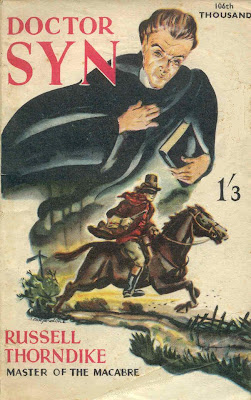Years later, I remembered very little about it---other than I thought it was really, really cool. In fact, some of my memories of it were false—I I always remembered it as being set in America during the Revolutionary War. (The Scarecrow is, after all, doing battle with Redcoats.)
But it turns out it was set in England, though it was during the reign of King George III. Dr. Syn is the vicar of a small church near Romney Marsh. At least that’s his day job. At night, he dresses as the Scarecrow (and, boy, is it a creepy-lookin’ costume) and leads a gang of smugglers, using the proceeds to help the locals pay their repressive taxes. Along the way, he repeatedly outwits the army officer tasked with catching him.
Dr. Syn came out on DVD recently and I picked up a copy. (And I’m lucky I did—apparently it sold out in just a few weeks time.) I did so with trepidations, since I knew that often stuff we thought was too cool for words as kids don’t always hold up when we see them as adults. I didn’t want to spoil my memories.
But there was nothing to worry about. Dr. Syn/Scarecrow, as played by Patrick McGoohan, actually is too cool for words. The three-part TV series (first aired on Disney’s Wonderful World of Color show) is superb old-fashioned storytelling, as the hero outwits the Redcoats, helps the downtrodden and rescues prisoners from dungeons. Over the course of the three episodes, he comes up with one multi-faceted plan after another that leaves his enemies perpetually bewildered.
I have, of course, since asked the pastor at my church why he or any of the other staff there never do stuff this cool. His answer, of course, was “How do you know we don’t?”
Seeing and enjoying the TV show again reminded me that I had never read the original book, written by Russell Thorndyke in 1915. I picked up a copy through Amazon and discovered that the literary Dr. Syn is a lot more of a scoundrel than his Disney counterpart. The book Syn is willing to act in an extremely ruthless manner that McGoohan’s character only pretended to capable of, including doing away with potential witnesses.

But once you get used to the idea that it’s a story about scoundrels on both sides of the law, then it’s still a ripping good yarn. The novel is written in a fast-moving, witty prose and peppered with entertaining supporting characters. (Some of them with wonderful names such as Sennacherib Pepper or Jerry Jerk.) Though Syn is no longer very heroic, his battle of wits with a British naval officer still makes for a good time. And there is a truly sympathetic character—the young girl Imogene, who is in love with the squire’s son—that we do end up rooting for with a clear conscience.
So here I am reading through this novel when I get to page 161 and—WHAM—the book just peters out without resolving the major plot lines. Well, that’s annoying.
Did I get a defective copy? No, I check Amazon and the page count they have matches. And, lo, several of the customer reviews mention the same problem.
It turns out this edition of Dr. Syn, the Scarecrow of Romney Marsh, published by Wildside Press, is the victim of either a sloppy production error or a bizarre editing decision, since it was published WITH THE LAST FEW CHAPTERS MISSING!!!!
Fortunately, the book is old enough to be in the public domain and I found the full text via Google Books, allowing me to finish reading it. But, gee whiz, my print copy still annoys me. Why would someone reprint a novel and leave off the ending?
Anyway, if you’re lucky enough to get hold of the DVD of Disney’s Dr. Syn, I recommend it highly. I also recommend the original book, though you need to be careful of what edition you get if you want to read the whole thing. The movie and the book represent two very thematically different versions of the character, but both are worth visiting.
The book was very successful when it first came out, prompting Thorndyke to write a number of others. These are prequels, detailing Syn’s adventures when he still went by the name of Captain Clegg and sailed the seas as a pirate. I’m going to get hold of those as well before long and read them as well. But, by golly, if any of them are missing their ending, I’ll take on the mantle of the Scarecrow myself and wage a just war against sloppy publishers the world over.




















